|
|
|
Sort Order |
|
|
|
Items / Page
|
|
|
|
|
|
|
| Srl | Item |
| 1 |
ID:
119460
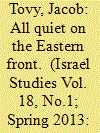

|
|
|
|
|
| Publication |
2013.
|
| Summary/Abstract |
The article reviews and analyzes the measures taken by Israel from the beginning of 1951 until the middle of 1956 in its attempt to extract collective compensation (referred to in Israeli terminology as shilumim and hereinafter as "reparations") from the GDR (East-Germany). Existing research on the subject has revealed that as of yet there has been almost no discussion of it. Only two sources have dealt in a substantive manner with Israel's attempts to obtain reparations from the GDR during 1951-56: Angelika Timm in a sub-chapter to the issue in Jewish Claims against East Germany, and Michael Wolffsohn's article, "Das Deutsch-Israelische Wiedergutmachungsabkommen von 1952 im Internationalen Zusammenhang." However, these two writers analyze the subject only briefly-each devoting only 8 pages to the issue, based on sources cited in some 30 footnotes. In contrast, this article provides an in-depth understanding of the subject, including all the aspects from different perspectives, some of which are not discussed in the above-mentioned writings. First and foremost, the article reviews all of the actions taken by Israel regarding this subject, while focusing on the connection that was made between the two Israeli claims for reparations: from the GDR and from FRG (West-Germany).
|
|
|
|
|
|
|
|
|
|
|
|
|
|
|
|
| 2 |
ID:
119420
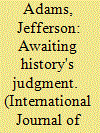

|
|
|
|
|
| Publication |
2013.
|
| Summary/Abstract |
On 10 June 2000, a group of roughly 200 mourners assembled at the Zentralfriedhof Berlin-Friedrichsfelde, the traditional resting place for those belonging to Germany's Communist pantheon beginning with Rosa Luxemburg and Karl Liebknecht. The occasion was the burial of Erich Mielke, the longstanding head of East Germany's Ministerium für Staatssicherheit (Ministry of State Security; MfS or Stasi) who had died the previous month of natural causes at the age of 92. Willi Opitz, the last rector of the MfS Juristische Hochschule (School of Law), headed the delegation and delivered the main eulogy. In the course of Opitz's remarks, Mielke was praised for his "energetic preservation and assertion of socialist law not only in our ministry but in all areas of state and society." In addition to his desire that "people live and work in security and dignity," he himself "radiated optimism, strength, and zest for life." Even after 1989-confronted by "prejudices based in revenge and victors' justice, degrading penal conditions, [and] the revocation of his entitlement to a VVN (Association of Victims of the Nazi Regime) pension"-Mielke remained unbroken. A few words of consolation were also directed at his widow, his son Frank, his adopted daughter Inge, and his two grandchildren, all in attendance.
|
|
|
|
|
|
|
|
|
|
|
|
|
|
|
|
| 3 |
ID:
085236
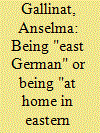

|
|
|
|
|
| Publication |
2008.
|
| Summary/Abstract |
An apparent resurgence of East German identity aroused much scholarly interest in recent years whilst it is contested in the German public discourse. Scholars see the phenomenon as based in experiences of domination and cultural devaluation; German scholars focus on East-West German differences, and the public discourse refers to the continuation of the "[Berlin] Wall in people's minds." When conducting field research in Saxony-Anhalt in 2001, I found, however, that my informants would consciously and carefully negotiate their senses of belonging. Many avoided claims to an exclusive identity category and instead emphasised more local senses of attachment which nevertheless encompassed the whole of eastern Germany. This article seeks to highlight the interplay of these two kinds of belonging. Its central argument is that they are two aspects of the same phenomenon. The article therefore explores how identity is based in the mundane and quotidian forms of everyday life leading to senses of belonging that allow for a reflexive positioning of the self and the other. This belonging is at certain times also voiced explicitly. The article also explores how and when identity rhetoric comes into play.
|
|
|
|
|
|
|
|
|
|
|
|
|
|
|
|
| 4 |
ID:
184870
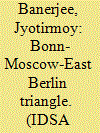

|
|
|
| 5 |
ID:
111182
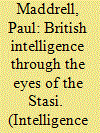

|
|
|
|
|
| Publication |
2012.
|
| Summary/Abstract |
The German parliament's Law on the Stasi Records, passed in 1991, extended the principle of freedom of information to the records of a Communist security service. By so doing, it has given historians, former targets of Stasi intelligence collection and others an unprecedented insight into the operations of such a service. Enough records of the Stasi's trials department have been made available to reconstruct a picture of the work of British intelligence agencies in the years 1945-61, and above all the work of the Secret Intelligence Service (SIS). They show that SIS was a very skilful service which obtained the high-grade intelligence it sought. However, SIS's work in East Germany was undone in the late 1950s by the treason of the KGB's penetration agent in it, George Blake.
|
|
|
|
|
|
|
|
|
|
|
|
|
|
|
|
| 6 |
ID:
132418
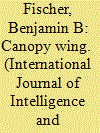

|
|
|
|
|
| Publication |
2014.
|
| Summary/Abstract |
Although Winston Churchill declared that history is always written by the victors, never the vanquished, a group of former East German foreign intelligence officers seem determined to prove him wrong. Calling themselves Insiders have been churning out books since the end of the Cold War that recount the history of that conflict from their perspective. The Insiders' mantra is that they were on the right, even if losing, side because they "spied for peace" to protect the Warsaw Pact against the existential threat posed by the "aggressive intentions" of the West.
|
|
|
|
|
|
|
|
|
|
|
|
|
|
|
|
| 7 |
ID:
082241
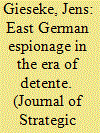

|
|
|
|
|
| Publication |
2008.
|
| Summary/Abstract |
East Germany was one of the main actors in Cold War military and security policy intelligence. Due to the opening of the archives of the Ministry for State Security (Stasi) of the German Democratic Republic it is possible today to analyse methods and goals of the East German civil and military intelligence services on this field in more detail. The article summarises the state of research on staff and sources of these services. Based on this information, main directions and operational fields are exemplified for military and international strategic intelligence in the era of d tente of the 1970s. Contents and quality of intelligence results are focused with respect to their potential influence on East German and Warsaw Pact (i.e. Soviet) decision-making processes.
|
|
|
|
|
|
|
|
|
|
|
|
|
|
|
|
| 8 |
ID:
108576
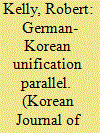

|
|
|
|
|
| Publication |
2011.
|
| Summary/Abstract |
This paper plots the greater difficulties of future Korean unification through a
comparison with Germany 1989/90. The balance of forces favors a more politicized,
more expensive, and more internationally contested Korean unification course
than in Germany. Domestically: there are more North Koreans than there were
East Germans, and they are much poorer. There are fewer South Koreans than
there were West Germans, and they are less wealthy also. South Korea's state
strength or capacity is lower than West Germany's was, while North Korea is a
semi-failed state, even by East German standards. So, fewer people with a lower
GDP per capita in a weaker system will support more people with less wealth from
a worse system. Internationally: today's external patron (the United States) of the
free Korean half is weakening, while the external patron (China) of the communist
half is strengthening. The opposite was true of the United States and West Germany,
and the Soviet Union and East Germany, in 1989. Today's northern patron (China)
is trying to push further into the Asian continent, while yesterday's eastern patron
(the Soviet Union) was looking for an exit from central Europe. Chinese peninsular
intervention is therefore easier, while U.S. support for South Korea's unification
terms will be more difficult.
|
|
|
|
|
|
|
|
|
|
|
|
|
|
|
|
| 9 |
ID:
041357
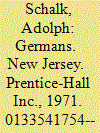

|
|
|
|
|
| Publication |
New Jersey, Prentice-Hall Inc., 1971.
|
| Description |
xxix, 521p.Hbk
|
| Standard Number |
0133541754
|
|
|
|
|
|
|
|
|
|
|
|
Copies: C:1/I:0,R:0,Q:0
Circulation
| Accession# | Call# | Current Location | Status | Policy | Location |
| 010060 | 943.087/SCH 010060 | Main | On Shelf | General | |
|
|
|
|
| 10 |
ID:
134043
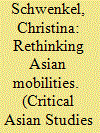

|
|
|
|
|
| Publication |
2014.
|
| Summary/Abstract |
Vietnam's economic reforms have generated much praise for the country's rapid "opening" of its markets, as if the Vietnamese nation had previously existed in a state of isolation, closed to broader global influences and exchanges. Such discourses overlook the importance of transnational circulations of people, goods, technologies, and expertise during the socialist era that were vital to Vietnam's postwar national reconstruction and continue to play a role in post-socialist economic transformation today. This article traces the socialist pathways of labor migration between Vietnam and the former Soviet Bloc (specifically, East Germany) in the 1980s, mobilities that are generally absent in studies of contemporary export labor industries. Based on multi-sited ethnographic and archival research, the author follows Vietnamese workers first to the East German factories where they labored as "contract workers," and then through their subsequent return and reintegration into Vietnamese society after the collapse of the Soviet Union. These mobilities bespeak of an alternative history and formation of diasporic communities that are little acknowledged or addressed in literature on labor migrations, and yet are important to understanding emerging forms of stratification today in Vietnam. Moreover, an analysis of early non-capitalist experiences with overseas labor regimes in the 1980s provides insights into contemporary Vietnamese governance practices that promote-rather uncritically, similar to other "emerging countries" -export labor as a nation-building strategy to reduce endemic poverty and develop a late socialist country.
|
|
|
|
|
|
|
|
|
|
|
|
|
|
|
|
| 11 |
ID:
142682
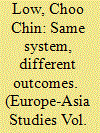

|
|
|
|
|
| Summary/Abstract |
Since 1955, one important trend regarding dual nationality was observable in East Germany and the People’s Republic of China (PRC): the official rejection of dual nationality itself. While East Germany’s effort in preventing dual nationality was motivated by the socialist nationality principles of its Eastern European allies, the PRC’s effort was aimed at ending its diplomatic isolation in the Southeast Asian region. In both states, bilateral treaties were preferred over national legislation in overcoming dual nationality. This article compares the implementation of a single nationality principle through bilateral treaties and suggests that the PRC’s effort was unsuccessful because it was confronted with unfavourable international circumstances compared to East Germany.
|
|
|
|
|
|
|
|
|
|
|
|
|
|
|
|
| 12 |
ID:
026114
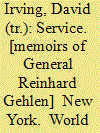

|
|
|
|
|
| Publication |
New York, World Publishing Company, 1972.
|
| Description |
xxi, 386p.Hbk
|
| Standard Number |
0529044552
|
|
|
|
|
|
|
|
|
|
|
|
Copies: C:1/I:0,R:0,Q:0
Circulation
| Accession# | Call# | Current Location | Status | Policy | Location |
| 014986 | 923.5/GEH 014986 | Main | On Shelf | General | |
|
|
|
|
| 13 |
ID:
138829
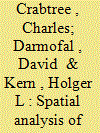

|
|
|
|
|
| Summary/Abstract |
Formal models of revolutionary collective action suggest that ‘informational cascades’ play a crucial role in overcoming collective action problems. These models highlight how information about the aggregate level of participation in collective action conveys information about others’ political preferences, and how such informational cues allow potential participants to update their beliefs about the value of participating in antiregime collective action. In authoritarian regimes, foreign mass media are often the only credible source of information about antiregime protests. However, limited robust evidence exists on whether foreign media can indeed serve as a coordination device for collective action. This article makes use of a detailed dataset on protest events during the 1989 East German revolution and exploits the fact that West German television broadcasts could be received in most but not all parts of East Germany. Across a wide range of Cox proportional hazards models and conditional on a rich set of observables, it finds that the availability of West German television did not affect the probability of protest events occurring. The evidence presented here does not support the widely accepted ‘fact’ that West German television served as a coordination device for antiregime protests during the East German revolution. More broadly, it also calls into question strong claims about the effects of communication technology on revolutionary collective action.
|
|
|
|
|
|
|
|
|
|
|
|
|
|
|
|
| 14 |
ID:
121893
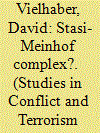

|
|
|
|
|
| Publication |
2013.
|
| Summary/Abstract |
The extent of the East German Ministry for State Security's involvement with militant left-wing terrorist organizations that operated in West Germany remains one of the most contentious issues with respect to the legacy of left-wing terrorism in Germany. Fueled by new archival evidence and much speculation, the topic has been the subject of many unfounded and sensationalist assertions. This article seeks to provide a chronological reassessment based on the current state of knowledge, and thus seeks to make a contribution to a growing literature on state involvement with terrorist groups. While the East German spy agency at times colluded with terrorist groups, the degree of support fluctuated considerably and there is no evidence that a state actor "created" the armed groups or "directed" their activities.
|
|
|
|
|
|
|
|
|
|
|
|
|
|
|
|
| 15 |
ID:
134895
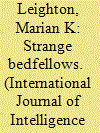

|
|
|
|
|
| Summary/Abstract |
A massive fortress-like structure dominating Normannenstrasse in East Berlin housed the headquarters of the East German Ministry for State Security (MfS), better known as the Stasi. It was a monument to the tasteless architecture of the Stalinist era. Passersby instinctively recoiled at the sight of the building. They could readily imagine the warren of cellblocks, interrogation rooms, and torture chambers deep inside its walls. Rumor had it that many of the cells were padded with burlap to muffle the screams of the torture victims, as well as to prevent prisoners from committing suicide by banging their heads to a bloody pulp against the concrete walls. The passersby also knew that an overzealous Stasi operative could emerge without warning to arrest and indict them for alleged crimes against the regime. Such “snoop and snatch” tactics were all part of a day's work for the MfS.
|
|
|
|
|
|
|
|
|
|
|
|
|
|
|
|
| 16 |
ID:
085515
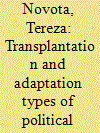

|
|
|
|
|
| Publication |
2008.
|
| Summary/Abstract |
The article argues that the German unification and the Eastern enlargement of the EU match with two types of democratization through common policy building that occurred after 1989- the Transplantation and the Adaptation Type of integration. The Transplantation exemplar stands for an immediate integration with no preconditions and economic backing of the accepting entity
|
|
|
|
|
|
|
|
|
|
|
|
|
|
|
|
| 17 |
ID:
110101
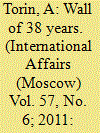

|
|
|
|
|
| Publication |
2011.
|
| Summary/Abstract |
NO OTHER EVENT has had more impact on modern European history than the Berlin Crisis of 1958-1961. Its culmination was the construction on August 13, 1961, of the famous Berlin Wall that divided East and West Germany and consolidated once and for all the existence of two German states - the Federal Republic of Germany and the German Democratic Republic.
The border between East and West Berlin had remained open until August 13, 1961. The dividing line measuring 44.75 kilometers (the total length of the border between West Berlin and East Germany was 164 km) passed directly through streets, houses, canals, and watercourses. Officially, there were 81 street crossing points and 13 passageways in the subway and on the city railroad. In addition, there were hundreds of illegal routes. Every day, between 300,000 and 500,000 people crossed the border between the two parts of the city for different reasons.1 The lack of a clear-cut physical boundary between sectors led to frequent conflicts and the mass departure of specialists to West Germany. East Germans preferred to get an education in the GDR, where it was free of charge, yet work in West Germany.
|
|
|
|
|
|
|
|
|
|
|
|
|
|
|
|
|
|
|
|
|